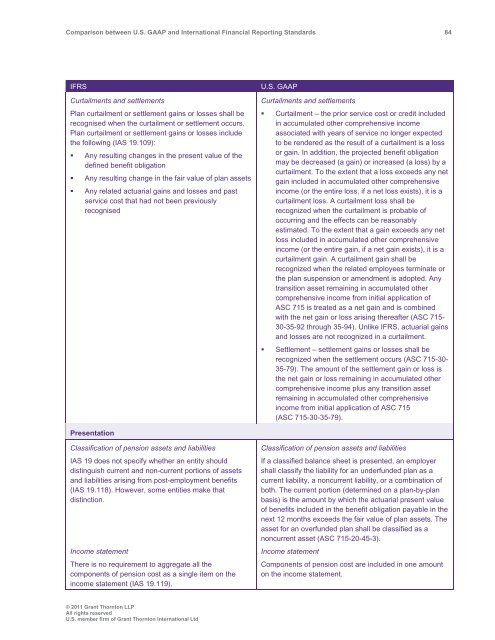Comparison between U.S. GAAP and International ... - Grant Thornton
Comparison between U.S. GAAP and International ... - Grant Thornton
Comparison between U.S. GAAP and International ... - Grant Thornton
You also want an ePaper? Increase the reach of your titles
YUMPU automatically turns print PDFs into web optimized ePapers that Google loves.
<strong>Comparison</strong> <strong>between</strong> U.S. <strong>GAAP</strong> <strong>and</strong> <strong>International</strong> Financial Reporting St<strong>and</strong>ards 84<br />
IFRS<br />
Curtailments <strong>and</strong> settlements<br />
Plan curtailment or settlement gains or losses shall be<br />
recognised when the curtailment or settlement occurs.<br />
Plan curtailment or settlement gains or losses include<br />
the following (IAS 19.109):<br />
• Any resulting changes in the present value of the<br />
defined benefit obligation<br />
• Any resulting change in the fair value of plan assets<br />
• Any related actuarial gains <strong>and</strong> losses <strong>and</strong> past<br />
service cost that had not been previously<br />
recognised<br />
U.S. <strong>GAAP</strong><br />
Curtailments <strong>and</strong> settlements<br />
• Curtailment – the prior service cost or credit included<br />
in accumulated other comprehensive income<br />
associated with years of service no longer expected<br />
to be rendered as the result of a curtailment is a loss<br />
or gain. In addition, the projected benefit obligation<br />
may be decreased (a gain) or increased (a loss) by a<br />
curtailment. To the extent that a loss exceeds any net<br />
gain included in accumulated other comprehensive<br />
income (or the entire loss, if a net loss exists), it is a<br />
curtailment loss. A curtailment loss shall be<br />
recognized when the curtailment is probable of<br />
occurring <strong>and</strong> the effects can be reasonably<br />
estimated. To the extent that a gain exceeds any net<br />
loss included in accumulated other comprehensive<br />
income (or the entire gain, if a net gain exists), it is a<br />
curtailment gain. A curtailment gain shall be<br />
recognized when the related employees terminate or<br />
the plan suspension or amendment is adopted. Any<br />
transition asset remaining in accumulated other<br />
comprehensive income from initial application of<br />
ASC 715 is treated as a net gain <strong>and</strong> is combined<br />
with the net gain or loss arising thereafter (ASC 715-<br />
30-35-92 through 35-94). Unlike IFRS, actuarial gains<br />
<strong>and</strong> losses are not recognized in a curtailment.<br />
• Settlement – settlement gains or losses shall be<br />
recognized when the settlement occurs (ASC 715-30-<br />
35-79). The amount of the settlement gain or loss is<br />
the net gain or loss remaining in accumulated other<br />
comprehensive income plus any transition asset<br />
remaining in accumulated other comprehensive<br />
income from initial application of ASC 715<br />
(ASC 715-30-35-79).<br />
Presentation<br />
Classification of pension assets <strong>and</strong> liabilities<br />
IAS 19 does not specify whether an entity should<br />
distinguish current <strong>and</strong> non-current portions of assets<br />
<strong>and</strong> liabilities arising from post-employment benefits<br />
(IAS 19.118). However, some entities make that<br />
distinction.<br />
Income statement<br />
There is no requirement to aggregate all the<br />
components of pension cost as a single item on the<br />
income statement (IAS 19.119).<br />
Classification of pension assets <strong>and</strong> liabilities<br />
If a classified balance sheet is presented, an employer<br />
shall classify the liability for an underfunded plan as a<br />
current liability, a noncurrent liability, or a combination of<br />
both. The current portion (determined on a plan-by-plan<br />
basis) is the amount by which the actuarial present value<br />
of benefits included in the benefit obligation payable in the<br />
next 12 months exceeds the fair value of plan assets. The<br />
asset for an overfunded plan shall be classified as a<br />
noncurrent asset (ASC 715-20-45-3).<br />
Income statement<br />
Components of pension cost are included in one amount<br />
on the income statement.<br />
© 2011 <strong>Grant</strong> <strong>Thornton</strong> LLP<br />
All rights reserved<br />
U.S. member firm of <strong>Grant</strong> <strong>Thornton</strong> <strong>International</strong> Ltd
















